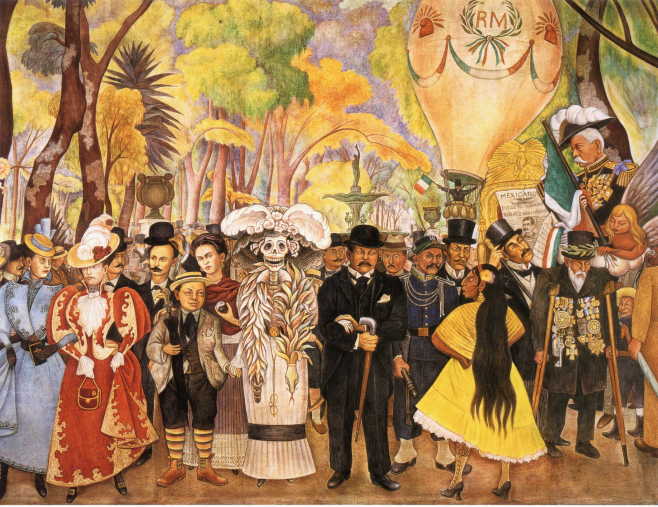Because we recently discussed the murals in Oaxaca, here is a re-post of a past article about murals in Mexico and the United States:
El Muralismo
One influence of Latino culture in many communities is highly visible in the presence of murals. Murals, large paintings on walls either inside or outside of buildings, are a common sight in many towns and cities, especially in the southwestern United States where there is a strong Mexican-American influence.
Muralismo Mexicano
The style and subject matter of these murals are the result of a trend that began in Mexico nearly a century ago: Muralismo, an artistic movement that surged in the 1920’s after the Mexican Revolution (1910-1919). Muralismo provided artists the opportunity to create art in places where the entire community could view them, making each painting a part of the structure of the city itself. Many of these murals were in important public spaces such as schools and government buildings. They often depicted famous moments in Mexican history and showed a wide range of people who made up that history, from indigenous people to modern politicians; from kings to regular working people. In this way, the artists were able to comment on what they thought about history, social issues and what it meant to be Mexican, all through their art.
The three most famous Mexican muralists, or “los tres grandes” were Diego Rivera, José Clemente Orozco and David Alfaro Siqueiros. Below are some examples of Diego Rivera’s work:

Diego Rivera, 1942, mural in the Palacio Nacional in Mexico City
The mural above depicts the marketplace of Tlatelolco, an Aztec city. This city was described in the following diary entry by a Spaniard arriving in Mexico in 1519: “After we had sufficiently gazed upon this magnificent picture, we again turned our eyes toward the great market, and beheld the vast numbers of buyers and sellers who thronged there. The bustle and noise occasioned by this multitude of human beings was so great that it could be heard at a distance of more than four miles. Some of our men, who had been at Constantinople and Rome, and travelled through the whole of Italy, said that they never had seen a market-place of such large dimensions, or which was so well regulated, or so crowded with people as this one at Mexico.” – Bernal Díaz del Castillo, 1519
Do you think the mural does a good job of depicting this city? Why do you think the artist would paint this city in his mural four centuries later?

Diego Rivera, staircase in the Palacio Nacional
Notice the eagle with the snake in the middle of the mural above. Where else have you seen this image?

Diego Rivera, “Dream of a Sunday Afternoon in Alameda Park,” 1948
Diego Rivera painted himself as a child in this mural (the short man-child holding the hand of the calavera, or skeleton). He also included his wife, Frida Kahlo behind him. What do you think is the significance of the calavera? What time period do you think this painting depicts? Does anything seem out of place?
Muralismo en los Estados Unidos
Today, Mexican Americans continue to celebrate their communities through muralismo. These murals still depict important events and people. Below are some examples of murals in the United States. What messages do you think the artists might have been trying to send to their communities through their art?

What does the bald eagle represent? The dove? In what other ways does the artist of this mural communicate his message?

What does the phrase “Sí se puede” mean? With that meaning in mind, what do you think the message of this mural is? What is the historical significance of this phrase?

The title of this mural is “Building Peace on Piece at a Time.” What “pieces” of peace does the artist include in the mural?
The news story below is an example of how murals can involve the whole community:
News story: West Side mural shows a healthier way of life






